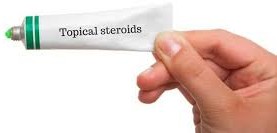A client with psoriasis returns to the clinic reporting the persistence of several silvery, scaly areas on the elbows and palms that frequently burn and sometimes bleed.
Which prescription should the nurse teach the client to use for the skin condition?
Colloidal oatmeal-based lotion.
Topical corticosteroids.
Topical analgesics.
Topical antifungal.
The Correct Answer is B
A Colloidal oatmeal-based lotion: Colloidal oatmeal can help to reduce itching and swelling, all while hydrating the skin. It is often used to soothe irritated skin and can be incorporated into a skincare routine through oatmeal baths or oatmeal-infused moisturizers. However, it is typically used as a complementary treatment and may not be sufficient to manage psoriasis symptoms on its own.
B Topical corticosteroids: These are an essential tool for treating inflammatory skin conditions such as psoriasis34. They work by reducing inflammation and slowing down the production of skin cells, which helps to alleviate symptoms such as redness, itching, and scaling. Topical corticosteroids are often the first line of treatment for mild to moderate psoriasis.

C. Topical analgesics: These are primarily used to relieve pain. While they may provide some relief from discomfort associated with psoriasis, they do not address the underlying inflammation and rapid skin cell production that characterize this condition.
D Topical antifungal: Antifungal agents are typically used to treat conditions like seborrheic dermatitis and scalp psoriasis, or in areas where psoriasis involves folds in the skin, where there is an increased potential for localized infection. However, they are not typically used as a primary treatment for psoriasis.
Nursing Test Bank
Naxlex Comprehensive Predictor Exams
Related Questions
Correct Answer is D
Explanation
Measuring oxygen saturation is not directly relevant to the administration of vancomycin or the monitoring of its potential side effects. While oxygen saturation is important to assess in patients with respiratory concerns, it does not provide information about kidney function, which is essential for safe vancomycin use.
Choice B rationale:
Auscultating bowel sounds, while a part of general abdominal assessment, is not the most crucial action before administering vancomycin. Vancomycin is not known to have significant effects on bowel motility, and its primary concern is nephrotoxicity.
Choice C rationale:
Assessing body temperature can be helpful in evaluating for infection, but it is not the most specific or sensitive indicator of vancomycin-related adverse effects. Fever can be a sign of various conditions, and it does not directly assess kidney function.
Choice D rationale:
Checking serum creatinine is the most essential action before administering vancomycin because it allows for assessment of kidney function. Vancomycin is primarily excreted by the kidneys, and impaired renal function can lead to elevated drug levels and increased risk of nephrotoxicity. By checking serum creatinine, the nurse can ensure that the patient's kidney function is adequate to safely excrete vancomycin and can adjust the dosage or frequency of administration if necessary.
Correct Answer is B
Explanation
Drinking plenty of water whenever thirsty is not the most appropriate action for a patient with hypernatremia. While it's important to stay hydrated, excessive water intake can potentially worsen hypernatremia by diluting blood sodium levels further. This is because the body tries to balance sodium levels by either retaining water or excreting it through urine. In hypernatremia, the body is already short on water relative to sodium, so consuming too much water can exacerbate the imbalance.
Choice B rationale:
Reviewing food labels for sodium content is crucial for managing hypernatremia. It empowers patients to make informed choices and limit their sodium intake.
Sodium is a major contributor to hypernatremia, and reducing dietary sodium intake is a key strategy to lower blood sodium levels.
By carefully reading food labels and selecting low-sodium options, patients can effectively manage their sodium intake and promote a gradual return to normal sodium levels.
This approach addresses the root cause of hypernatremia and promotes long-term control of blood sodium levels.
Choice C rationale:
Monitoring daily urine output volume can be helpful in tracking fluid status, but it's not the primary action for managing hypernatremia.
While urine output can provide insights into fluid balance, it doesn't directly address the underlying issue of excessive sodium. Focusing on dietary sodium intake is a more direct and effective approach to correcting hypernatremia.
Choice D rationale:
Using salt tablets after strenuous exercise is not recommended for patients with hypernatremia.
Salt tablets are intended to replenish electrolytes lost through sweating, but they can worsen hypernatremia by further increasing sodium levels.
Patients with hypernatremia should focus on reducing sodium intake, not increasing it.
Whether you are a student looking to ace your exams or a practicing nurse seeking to enhance your expertise , our nursing education contents will empower you with the confidence and competence to make a difference in the lives of patients and become a respected leader in the healthcare field.
Visit Naxlex, invest in your future and unlock endless possibilities with our unparalleled nursing education contents today
Report Wrong Answer on the Current Question
Do you disagree with the answer? If yes, what is your expected answer? Explain.
Kindly be descriptive with the issue you are facing.
